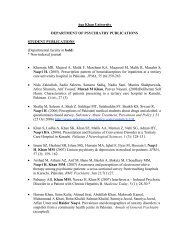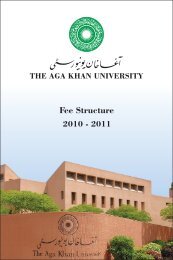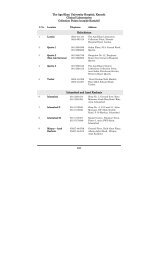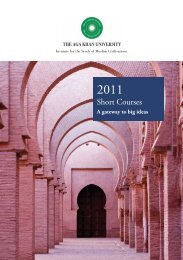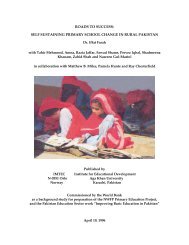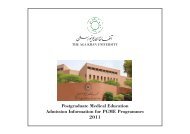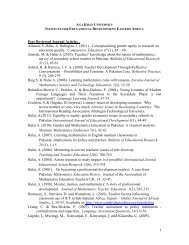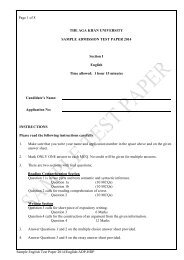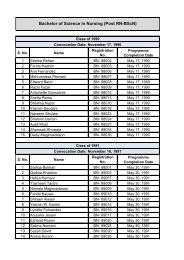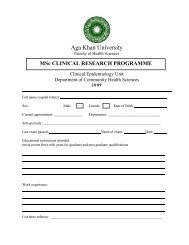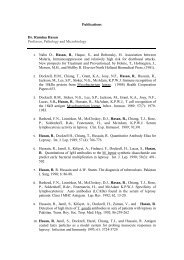Physics
Physics
Physics
You also want an ePaper? Increase the reach of your titles
YUMPU automatically turns print PDFs into web optimized ePapers that Google loves.
Topics and Student Learning Outcomes of the Examination Syllabus<br />
Part – I (Class XI)<br />
1. Measurement<br />
Topics<br />
Candidates should be able to:<br />
Student Learning Outcomes<br />
Cognitive level 2<br />
K U A<br />
1.1 Scope of physics<br />
1.1.1 describe the importance of physics in science, technology and society; *<br />
1.2 S.I Units 1.2.1 describe S.I base units, derived units and supplementary units for<br />
various measurements;<br />
1.2.2 show the derived units as products or quotients of the base units;<br />
1.3 Errors and Uncertainty 1.3.1 differentiate between systematic and random errors;<br />
1.3.2 identify the uncertainty in the derived quantity;<br />
*<br />
*<br />
*<br />
*<br />
1.4 Precision and Accuracy 1.4.1 give two differences between precision and accuracy; *<br />
1.5 Significant figures 1.5.1 show answers with correct scientific notations, number of significant<br />
figures in all numericals;<br />
1.5.2 identify that least count (L.C) of an instrument is the smallest<br />
increment measurable by it;<br />
1.6 Dimensions 1.6.1 show the homogeneity of three physical equations by using dimension<br />
and basic units;<br />
1.6.2 derive formula for three physical quantities by using dimensions.<br />
*<br />
*<br />
*<br />
*<br />
2 K = Knowledge, U = Understanding, A= Application (for explanation see section 6: Definition of command words used in Student Learning Outcomes and in Examination<br />
Questions).<br />
1
2. Vectors and Equilibrium<br />
Candidates should be able to:<br />
K U A<br />
2.1 Cartesian coordinate system<br />
2.2 Addition of vectors by head<br />
to tail rule<br />
2.1.1 describe the Cartesian coordinate system in two and three dimension<br />
systems;<br />
2.2.1 explain the sum of vectors using head to tail rule;<br />
2.2.2 define resultant, negative, unit, null, position and equal vectors;<br />
2.2.3 represent a vector into its rectangular components;<br />
*<br />
*<br />
*<br />
*<br />
2.3 Addition of vectors by<br />
rectangular component<br />
method<br />
2.3.1 determine the sum of vectors using perpendicular components; *<br />
2.4 Scalar product of two<br />
vectors<br />
2.4.1 define scalar product of two vectors;<br />
2.4.2 describe the scalar product of two vectors in terms of angle between<br />
them;<br />
2.4.3 discuss any five properties of scalar product of two vectors;<br />
*<br />
*<br />
*<br />
2.5 Vector product of two<br />
vectors<br />
2.5.1 define vector product of two vectors;<br />
2.5.2 describe vector product of two vectors in terms of angle between them;<br />
2.5.3 discuss any five properties of vector product;<br />
2.6 Torque 2.6.1<br />
r r<br />
define torque as a vector product of × F ;<br />
2.6.2 list two applications of torque;<br />
2.7 Equilibrium of forces 2.7.1 define equilibrium;<br />
2.7.2 state first and second condition of equilibrium.<br />
*<br />
*<br />
*<br />
*<br />
*<br />
*<br />
*<br />
2
3. Motion and Force<br />
Candidates should be able to:<br />
K U A<br />
3.1 Displacement<br />
3.1.1 define displacement with illustrations; *<br />
3.2 Velocity 3.2.1 define velocity, average velocity and instantaneous velocity with<br />
illustrations;<br />
3.2.2 define acceleration, average acceleration and instantaneous acceleration;<br />
3.2.3 manipulate velocity-time graph for constant direction and understand<br />
significance of area under velocity-time graph;<br />
*<br />
*<br />
*<br />
3.3 Acceleration 3.3.1 summarize the equations of motion for uniformly accelerated bodies in a<br />
straight line and in uniform gravitational field in a non-resistive<br />
medium;<br />
*<br />
3.4 Equations of motion 3.4.1 state Newton’s laws of motion; *<br />
3.5 Force, Momentum and<br />
Impulse<br />
3.5.1 describe the relation between Newton’s 2 nd law of motion and the rate of<br />
change of momentum;<br />
3.5.2 infer impulse as product of impulsive force and time;<br />
3.5.3 describe law of conservation of momentum;<br />
3.5.4 apply law of conservation of momentum and study the special cases of<br />
elastic collision between two bodies in one dimension;<br />
3.5.5 describe the force produced due to flow of water;<br />
3.5.6 apply the law of conservation of momentum to study explosive forces;<br />
*<br />
*<br />
*<br />
*<br />
*<br />
*<br />
3.6 Projectile 3.6.1 explain forces applied on the process of rocket propulsion;<br />
3.6.2 define projectile, projectile motion and trajectory of projectile;<br />
3.6.3 describe projectile motion in non-resistive medium;<br />
3.6.4 derive the relation for time of flight, maximum height and horizontal<br />
range of a projectile;<br />
3.6.5 relate the motion of ballistic missiles with projectile motion.<br />
*<br />
*<br />
*<br />
*<br />
*<br />
3
4. Work, Power and Energy<br />
Candidates should be able to:<br />
K U A<br />
4.1 Work<br />
4.1.1 define work;<br />
4.1.2 describe work when force and displacement are acting at an angle (θ);<br />
4.1.3 list three different units of work;<br />
4.1.4 distinguish between positive, negative and zero work with three<br />
examples;<br />
4.1.5 describe work done by variable and constant forces;<br />
*<br />
*<br />
*<br />
*<br />
*<br />
4.2 Work done in a gravitational<br />
field<br />
4.2.1 explain the work done in a gravitational field; *<br />
4.3 Power 4.3.1 define power. Also write down its dimension;<br />
4.3.2 list three different units of power;<br />
4.3.3 derive a formula of power in terms of force and velocity;<br />
4.4 Energy 4.4.1 define energy;<br />
4.4.2 differentiate between potential and kinetic energy;<br />
4.4.3 write three different units of energy;<br />
4.5 Work-energy relation 4.5.1 describe how energy is related with work<br />
CASES<br />
(i) when friction is present<br />
(ii) when friction is not present;<br />
*<br />
*<br />
*<br />
*<br />
*<br />
*<br />
*<br />
4.6 Absolute gravitational<br />
energy<br />
4.6.1 analyse the absolute gravitational energy and derive an expression for<br />
absolute P.E;<br />
*<br />
4.7 Escape velocity 4.7.1 describe the concept of escape velocity;<br />
4.7.2 derive the formula for escape velocity;<br />
4.7.3 compute escape velocity for the Moon and the Earth when mass and<br />
radius of the bodies are given;<br />
*<br />
*<br />
*<br />
4
4.8 Conservation of energy 4.8.1 state and explain the law of conservation of energy;<br />
4.8.2 interconversion of potential energy and kinetic energy in a resistive<br />
medium;<br />
K U A<br />
*<br />
*<br />
4.9 Types of energy sources 4.9.1 list the conventional and non-conventional energies;<br />
4.9.2 describe the uses of energy.<br />
5. Circular Motion<br />
Candidates should be able to:<br />
*<br />
*<br />
5.1 Angular motion<br />
5.1.1 define angular displacement, angular velocity and angular acceleration;<br />
5.1.2 produce the relation between linear and angular displacement, velocity<br />
and acceleration;<br />
*<br />
*<br />
5.2 Centripetal force and<br />
Centripetal acceleration<br />
5.2.1 define centripetal force and centripetal acceleration;<br />
5.2.2 derive centripetal acceleration when velocity is uniform;<br />
5.2.3 convert centripetal acceleration in terms of angular velocity;<br />
*<br />
*<br />
*<br />
5.3 Moment of inertia 5.3.1 define moment of inertia;<br />
5.3.2 define the formula for moment of inertia;<br />
5.4 Angular momentum 5.4.1 define angular momentum;<br />
5.4.2 write S.I unit and dimension of angular momentum;<br />
5.4.3 state and explain law of conservation of angular momentum;<br />
5.5 Rotational kinetic energy 5.5.1 define rotational kinetic energy;<br />
5.5.2 derive an expression for rotational kinetic energy;<br />
*<br />
*<br />
*<br />
*<br />
*<br />
*<br />
*<br />
5.6 Artificial satellites and<br />
weightlessness<br />
5.6.1 define weightlessness in artificial satellites;<br />
5.6.2 categorize the different types of satellites;<br />
5.6.3 explain how artificial gravity can be produced when a satellite revolves<br />
around the earth;<br />
*<br />
*<br />
*<br />
5
5.7 Orbital velocity 5.7.1 define orbital velocity;<br />
5.7.2 derive a relation for orbital velocity;<br />
K U A<br />
*<br />
*<br />
5.8 Newton’s and Einstein’s<br />
views on gravitation<br />
6. Fluid Dynamics<br />
5.8.1 differentiate between Newton’s and Einstein views on gravitation. *<br />
Candidates should be able to:<br />
6.1 Streamline and Turbulent<br />
flow<br />
6.1.1 define streamline and turbulent flow and state the conditions for<br />
turbulent flow;<br />
*<br />
6.2 Equation of continuity 6.2.1 derive the equation of continuity and on the basis of this equation<br />
describe the motion of a rocket;<br />
*<br />
6.3 Bernoulli’s equation 6.3.1 derive Bernoulli’s equation;<br />
6.3.2 interpret and apply Bernoulli Effect in the; filter pump, venturi meter<br />
and atomizers;<br />
6.3.3 solve problems by the help of Bernoulli’s equation;<br />
*<br />
*<br />
*<br />
6.4 Viscous fluids 6.4.1 define viscous and non-viscous fluids;<br />
6.4.2 describe that viscous force in a fluid causes a retarding force on an<br />
object moving through it;<br />
*<br />
*<br />
6.5 Fluid friction 6.5.1 define fluid friction;<br />
6.5.2 apply dimensional analysis to confirm the form of the stokes law;<br />
6.5.3 apply Stokes law to derive an expression for terminal velocity of<br />
spherical body falling through viscous fluids;<br />
*<br />
*<br />
*<br />
6.6 Terminal velocity 6.6.1 define terminal velocity and describe the factors on which it depends. *<br />
6
7. Oscillations<br />
Candidates should be able to:<br />
K U A<br />
7.1 Simple harmonic motion<br />
(SHM)<br />
7.2 Uniform circular motion and<br />
SHM<br />
7.1.1 define the following terms: oscillatory motion, periodic motion, time<br />
period, frequency, amplitude;<br />
7.1.2 state and derive Hook’s law;<br />
7.1.3 derive an expression for acceleration of a body vibrating under elastic<br />
restoring force;<br />
7.2.1 discuss SHM on the basis of uniform circular motion;<br />
7.2.2 derive expression for displacement, instantaneous velocity and<br />
acceleration in terms of ( ω );<br />
*<br />
*<br />
*<br />
*<br />
*<br />
7.3 Phase 7.3.1 define phase angle;<br />
7.3.2 derive an expression for the displacement “x”;<br />
*<br />
*<br />
7.4 A horizontal mass-spring<br />
system.<br />
7.4.1 derive an expression for instantaneous velocity in case of horizontal<br />
mass-spring system;<br />
*<br />
7.5 Simple pendulum 7.5.1 define simple pendulum also show that its motion is SHM;<br />
7.5.2 derive an expression for the time period of simple pendulum;<br />
7.6 Energy conservation in SHM 7.6.1 relate between P.E, K.E and total energy for a body oscillating with<br />
SHM;<br />
*<br />
*<br />
*<br />
7.7 Free and Forced oscillation 7.7.1 explain free and forced oscillation with three examples; *<br />
7.8 Resonance 7.8.1 explain the phenomenon of resonance, give its three examples also list<br />
its different applications;<br />
*<br />
7.9 Damped oscillations 7.9.1 define damped oscillation, list down its different applications. *<br />
7
8. Waves<br />
Candidates should be able to:<br />
K U A<br />
8.1 Wave motion<br />
8.1.1 define wave motion with the help of two examples;<br />
8.1.2 define periodic waves;<br />
8.1.3 describe the propagation of waves with the help of an example;<br />
8.1.4 define progressive waves;<br />
8.1.5 explain how energy is transferred through a progressive wave;<br />
8.1.6 differentiate between transverse and longitudinal waves;<br />
8.1.7 show the relation V = υ λ ;<br />
*<br />
*<br />
*<br />
*<br />
*<br />
*<br />
*<br />
8.2 Speed of sound 8.2.1 show that the speed of sound depends on the properties of medium in<br />
which it propagates;<br />
8.2.2 describe Newton’s formula for speed of sound;<br />
8.2.3 discuss Laplace’s correction in Newton’s formula;<br />
8.2.4 manifest the effects of pressure, density and temperature on the speed of<br />
sound in air;<br />
8.2.5 show the expression V = V o + 0.61 t;<br />
*<br />
*<br />
*<br />
*<br />
*<br />
8.3 Superposition of waves 8.3.1 state the principle of superposition of two waves;<br />
8.3.2 describe the phenomenon of interference of sound waves;<br />
8.3.3 discriminate the formation of beats giving an illustration;<br />
*<br />
*<br />
*<br />
8.4 Stationary waves 8.4.1 define stationary waves and describe their formation using graphical<br />
approach;<br />
8.4.2 define the terms nodes and antinodes;<br />
8.4.3 describe with illustration the formation of stationary waves in string;<br />
8.4.4 identify the formation of stationary waves in a vibrating air column;<br />
8.4.5 describe modes of vibration in string and explain using L = n λ / 2;<br />
*<br />
*<br />
*<br />
*<br />
*<br />
8
8.5 Doppler’s effect 8.5.1 define Doppler’s effect;<br />
8.5.2 derive the relation between the original frequency of source of sound<br />
and the apparent frequency detected by the listener in four different<br />
conditions;<br />
8.5.3 explain that the Doppler’s effect is also applicable in electromagnetic<br />
waves;<br />
8.5.4 apply Doppler’s effect to understand the following: radar, sonar,<br />
astronomy and satellites;<br />
K U A<br />
*<br />
*<br />
*<br />
*<br />
8.6 Ultrasonic waves 8.6.1 define ultrasonic waves;<br />
8.6.2 determine the principle of generation and detection of ultrasonic waves;<br />
8.6.3 interpret the principle used in ultrasound for diagnostic purposes.<br />
*<br />
*<br />
*<br />
9. Physical Optics<br />
Candidates should be able to:<br />
9.1 Nature of light<br />
9.1.1 discuss different point of views about nature of light briefly;<br />
9.1.2 understand the concept of wave front;<br />
9.1.3 state Hygen’s principle and use it to explain linear superposition of<br />
light;<br />
*<br />
*<br />
*<br />
9.2 Interference of light 9.2.1 define interference of light and necessary conditions for it;<br />
9.2.2 describe and explain Young’s double slit experiment;<br />
9.2.3 derive relation for fringe spacing;<br />
*<br />
*<br />
*<br />
9.3 Interference in thin films 9.3.1 give basic concept of interference in thin films; *<br />
9.4 Newton’s ring 9.4.1 explain the phenomenon of formation of Newton’s rings and give three<br />
examples;<br />
*<br />
9.5 Michelson’s interferometer 9.5.1 understand the working and use of Michelson’s interferometer; *<br />
9
9.6 Diffraction of light 9.6.1 define diffraction of light;<br />
9.6.2 describe diffraction of light by diffraction gratting;<br />
9.6.3 describe and explain diffraction in a narrow slit;<br />
9.6.4 describe X-rays diffraction through crystals;<br />
K U A<br />
*<br />
*<br />
*<br />
*<br />
9.7 Bragg’s law 9.7.1 define Bragg’s law;<br />
9.7.2 derive the equation 2 d sin θ = m λ;<br />
*<br />
*<br />
9.8 Polarization 9.8.1 define polarization;<br />
9.8.2 understand polarization as a phenomenon associated with transverse<br />
waves;<br />
9.8.3 recognize and express that polarization is a product by a polaroid.<br />
*<br />
*<br />
*<br />
10. Thermodynamics<br />
Candidates should be able to:<br />
10.1 Kinetic theory of gases<br />
10.1.1 state basic postulates of kinetic theory of gases;<br />
10.1.2 calculate pressure on a gas molecule inside a gas container;<br />
10.1.3 interpret temperature in terms of kinetic energy;<br />
*<br />
*<br />
*<br />
10.2 Gas laws 10.2.1 define Boyle’s and Charle’s law with the help of kinetic theory; *<br />
10.3 Internal energy 10.3.1 explain that internal energy is function of state and is independent of<br />
paths;<br />
*<br />
10.4 Work and heat 10.4.1 describe that heat flow and work are two form of energy transfer<br />
between systems and calculate the heat beings transferred;<br />
10.4.2 express work in terms of change in volume;<br />
*<br />
*<br />
10
10.5 Thermodynamics 10.5.1 define thermodynamics and thermal equilibrium;<br />
10.5.2 state and explain 1st law of thermodynamics;<br />
10.5.3 apply the 1st law of thermodynamics in (i) isothermal, (ii) adiabatic,<br />
(iii) isobaric, (iv) isochoric;<br />
10.5.4 describe 1st law of thermodynamics in terms of change in internal<br />
energy, work done on the system and work done by the system;<br />
10.5.5 explain 1 st law of thermodynamics in terms of conservation of energy;<br />
K U A<br />
*<br />
*<br />
*<br />
*<br />
*<br />
10.6 Specific and Molar specific<br />
heat of gases.<br />
10.6.1 define the terms: (i) specific heat (ii) molar specific heat;<br />
10.6.2 apply 1st law of thermodynamics to show that C p − Cv<br />
= R , also<br />
explainC p > ;<br />
Cv<br />
*<br />
*<br />
10.7 Reversible and Irreversible<br />
process<br />
10.8 Second Law of<br />
thermodynamics<br />
10.7.1 define reversible and irreversible process; *<br />
10.8.1 state and explain the 2 nd law of thermodynamics with the help of<br />
schematic diagram;<br />
*<br />
10.9 Carnot engine 10.9.1 define heat engine in terms of 2 nd law of thermodynamics;<br />
10.9.2 explain the working principle of carnot engine with its four processes<br />
and also draw PV diagram;<br />
10.9.3 derive the formula for efficiency of carnot engine and explain it;<br />
*<br />
*<br />
*<br />
11
10.10 Refrigerator 10.10.1 describe refrigerator as it is a reverse of heat engine and derive<br />
expression for its efficiency;<br />
K U A<br />
*<br />
10.11 Entropy 10.11.1 explain the term entropy;<br />
10.11.2 describe positive and negative entropy;<br />
10.11.3 explain that increase in entropy is an evidence of increase of<br />
temperature of a system;<br />
10.11.4 appreciate environmental crisis as an entropy crisis.<br />
*<br />
*<br />
*<br />
*<br />
12
Part-II (Class XII)<br />
11. Electrostatics<br />
Candidates should be able to:<br />
K U A<br />
11.1 Electrostatics<br />
11.1.1 define charge and types of charge; *<br />
11.2 Coulomb’s law 11.2.1 state and explain Coulomb’s law for static charges;<br />
11.2.2 describe briefly the effect of medium on coulomb’s force;<br />
11.2.3 apply the principle of electrostatic phenomenon on ink-jet printer and<br />
photocopier;<br />
*<br />
*<br />
*<br />
11.3 Electric field and Electric<br />
intensity<br />
11.3.1 define electric intensity and derive an expression for the magnitude of<br />
electric field of a distance or from a point charge “q”;<br />
11.3.2 draw electric field lines due to<br />
(i) same charges,<br />
(ii) opposite charges;<br />
11.3.3 describe the concept of electric dipole;<br />
*<br />
*<br />
*<br />
11.4 Electric flux 11.4.1 define and explain electric flux; *<br />
11.5 Gauss’s law with its<br />
applications<br />
11.5.1 state and explain Gauss’s law;<br />
11.5.2 apply Gauss’s law to find field due to a hollow charged spherical<br />
conductor near charged plane surface and between two oppositely<br />
charged plates;<br />
*<br />
*<br />
11.6 Electric potential 11.6.1 define electric potential at a point in terms of work done in bringing a<br />
unit charge from infinity to that point;<br />
11.6.2 define unit of electric potential;<br />
11.6.3 describe electric field as potential gradient;<br />
11.6.4 define electron volt (eV);<br />
*<br />
*<br />
*<br />
*<br />
13
11.7 Capacitor 11.7.1 define capacitance of a capacitor and its S.I unit;<br />
11.7.2 describe functions of capacitors in simple circuit by drawing a labelled<br />
diagram;<br />
11.7.3 calculate capacitance of different capacitors in series and in a parallel<br />
using formulas;<br />
11.7.4 explain polarization of dielectric of a capacitor;<br />
K U A<br />
*<br />
*<br />
*<br />
*<br />
11.8 Energy stored in a capacitor 11.8.1 prove that energy stored in a capacitor is W = ½ QV and W = ½ CV 2 . *<br />
12. Current Electricity<br />
Candidates should be able to:<br />
12.1 Current Electricity<br />
12.1.1 define current;<br />
12.1.2 describe the flow of current in a conductor;<br />
12.1.3 distinguish any two points between conventional and non-conventional<br />
current;<br />
*<br />
*<br />
*<br />
12.2 Resistance 12.2.1 define resistance and conductance;<br />
12.2.2 define voltage;<br />
12.2.3 state Ohm’s law and give one example of a conductor which obeys<br />
ohm’s law;<br />
12.2.4 explain any three factors on which resistance depends;<br />
12.2.5 explain non-ohmic relationship between current and voltage for semiconductor<br />
diode and a filament lamp;<br />
*<br />
*<br />
*<br />
*<br />
*<br />
14
12.3 Resistivity and Conductivity 12.3.1 define resistivity;<br />
12.3.2 define conductivity;<br />
12.3.3 give three differences between resistivity and conductivity;<br />
12.3.4 derive a relation between resistance and resistivity;<br />
12.3.5 show a relation between temperature and resistance;<br />
12.3.6 calculate the value of carbon resistance by using colour code.<br />
K U A<br />
*<br />
*<br />
*<br />
*<br />
*<br />
*<br />
12.4 Internal resistance 12.4.1 define emf;<br />
12.4.2 derive a relation between emf and P.D with the help of formula;<br />
12.4.3 give any two examples of effect of internal resistance on external circuit<br />
in terms of current and voltage;<br />
12.4.4 define power;<br />
12.4.5 calculate the formula of power in terms of I, V and R;<br />
12.4.6 calculate the power dissipation due to the internal resistance of a circuit;<br />
*<br />
*<br />
*<br />
*<br />
*<br />
*<br />
12.5 Kirchoff’s laws 12.5.1 state Kirchoff’s Laws;<br />
12.5.2 show conservation of charge in a circuit with the help of Kirchoff’s 1st<br />
law;<br />
12.5.3 show conservation of energy in a circuit with the help of Kirchoff’s 2 nd<br />
law;<br />
*<br />
*<br />
*<br />
12.6 Potential divider 12.6.1 define potential divider with two examples;<br />
12.6.2 briefly explain the construction and working of a rheostat with the help<br />
of a diagram;<br />
12.6.3 explain the functions of a rheostat as a potential divider;<br />
*<br />
*<br />
*<br />
15
12.7 Balanced potential 12.7.1 define Wheatstone bridge with the help of diagram;<br />
12.7.2 describe the usage of Whetstone bridge to measure unknown resistance;<br />
12.7.3 define potentiometer with the help of diagram;<br />
12.7.4 demonstrate the measurement and comparison of emfs by using<br />
potentiometer;<br />
12.7.5 show that potentiometer is the most accurate device for emf’s<br />
measurement and comparison.<br />
K U A<br />
*<br />
*<br />
*<br />
*<br />
*<br />
13. Electromagnetisms<br />
Candidates should be able to:<br />
13.1 Current carrying conductor in a<br />
magnetic field<br />
13.1.1 define domain theory;<br />
13.1.2 give a comparison between strong and weak magnetic fields;<br />
13.1.3 derive an expression for force F = ILB sinθ ;<br />
13.1.4 differentiate between magnetic flux and magnetic flux density;<br />
13.1.5 give the factors governing field produced by long straight wire;<br />
13.1.6 derive the equation for flux φ = B . A<br />
;<br />
13.1.7 state and explain Ampere’s current law and its use to find the magnetic<br />
flux density inside a solenoid;<br />
13.1.8 give applications of Ampere’s law;<br />
*<br />
*<br />
*<br />
*<br />
*<br />
*<br />
*<br />
*<br />
13.2 Force on a moving charged<br />
particle<br />
13.2.1 derive equation for force on a moving charge in a uniform magnetic<br />
field and (beam of particles);<br />
13.2.2 calculate e/m value by using beam of charged particles in a uniform<br />
magnetic field;<br />
*<br />
*<br />
16
13.3 Cathode rays oscilloscope<br />
(CRO)<br />
K U A<br />
13.3.1 briefly describe basic principle and uses of CRO; *<br />
13.4 Current carrying rectangular<br />
coils in a uniform magnetic<br />
field<br />
13.4.1 derive an expression of torque due to a couple acting on a coil;<br />
13.4.2 define sensitivity of galvanometer; *<br />
*<br />
13.5 Electrical instruments 13.5.1 briefly explain the principle, construction and working of galvanometer,<br />
voltmeters , ammeter, AVO meter analogue and digital multimetre<br />
(DMM);<br />
13.5.2 explain different types of galvanometer;<br />
13.5.3 list the important steps to change G.M into voltmeter and ammeter.<br />
*<br />
*<br />
*<br />
14. Electromagnetic induction<br />
Candidates should be able to:<br />
14.1 Law of electromagnetic<br />
induction<br />
14.1.1 describe electromagnetic induction;<br />
14.1.2 explain Faraday’s law of electromagnetic induction;<br />
14.1.3 apply Lenz’s law to determine the direction of induced emf;<br />
*<br />
*<br />
*<br />
14.2 Inductance 14.2.1 distinguish between inductance and induction;<br />
14.2.2 explain self and mutual induction with formula and define its units;<br />
14.3 Energy stored in an inductor 14.3.1 evaluate the formula<br />
14.4 Simple AC generator, DC<br />
generator and DC motor<br />
an inductor;<br />
1<br />
2<br />
2<br />
E = L I and show how the energy is stored in<br />
14.4.1 describe principle, construction and working of an AC and DC<br />
generator;<br />
14.4.2 difference between AC and DC generators;<br />
14.4.3 Identify back emf in motor and back motor effect in generator;<br />
*<br />
*<br />
*<br />
*<br />
*<br />
*<br />
17
14.5 Transformer 14.5.1 describe the principle, construction and working of a transformer;<br />
14.5.2 differentiate between step up and step down transformer;<br />
14.5.3 uses of step up and step down transformers in daily life;<br />
14.5.4<br />
N<br />
s<br />
Vs<br />
show = and V<br />
sI<br />
s<br />
= VpI<br />
p<br />
for an ideal transformer, use given<br />
N V<br />
p<br />
p<br />
equation to solve problems;<br />
14.5.5 describe the simple energy losses due to eddy current and hystersis.<br />
K U A<br />
*<br />
*<br />
*<br />
*<br />
*<br />
15. Alternating Current<br />
15.1 Root mean square value (rms)<br />
Candidates should be able to:<br />
15.1.1 define alternating current;<br />
15.1.2 describe time period, frequency, the peak and rms value of alternate<br />
current and alternate voltage;<br />
15.1.3 interpret sinusoidal waves;<br />
*<br />
*<br />
*<br />
15.2 AC Circuits 15.2.1 explain flow of AC through resister, capacitor and inductor;<br />
15.2.2 show how ‘phase lag lead’ in a circuit through a vector diagram;<br />
*<br />
*<br />
15.3 Impedance 15.3.1 describe impedance as vector summation of resistance in series<br />
(R-C and R-L) circuits);<br />
*<br />
15.4 Power in AC circuits 15.4.1 knowledge and uses of formula for AC power P = VI cos θ<br />
(power factor), use this equation in solving problems;<br />
*<br />
18
15.5 Resonant circuit 15.5.1 generalise knowledge about the resonance circuit and quantitative<br />
understanding of the properties of the circuits containing inductors and<br />
capacitors in series and parallel;<br />
15.5.2 outline the principle of metal detector for security checks and choke coil;<br />
15.5.3 know the uses of cardiogram;<br />
K U A<br />
*<br />
*<br />
*<br />
15.6 Three phase AC supply 15.6.1 describe three phase AC supply; *<br />
15.7 Electromagnetic waves 15.7.1 know the electromagnetic waves and spectrum<br />
(ranging from radio waves to gamma rays);<br />
15.7.2 know the production, transmission and receptions of EM waves;<br />
15.7.3 describe the amplitude modulation (A.M) and frequency modulation<br />
(F.M).<br />
*<br />
*<br />
*<br />
16. <strong>Physics</strong> of Solids<br />
Candidates should be able to:<br />
16.1 Classification of solids<br />
16.1.1 distinguish between the structure of crystalline, amorphous and<br />
polymeric solids;<br />
16.1.2 define lattice and unit cell;<br />
*<br />
*<br />
16.2 Mechanical properties of<br />
solids.<br />
16.2.1 differentiate between elastic and plastic deformations in solids;<br />
16.2.2 define tensile compression stress;<br />
16.2.3 define Young’s modulus, shear modulus and bulk modulus and derive<br />
their formulae;<br />
16.2.4 define elastic limit and yields strength;<br />
16.2.5 deduce the strain energy in a deform materials from the area under the<br />
force extension graph;<br />
*<br />
*<br />
*<br />
*<br />
*<br />
19
16.3 Electric properties of solids 16.3.1 define conductors, insulators and semi conductors;<br />
16.3.2 describe energy bands in solids;<br />
16.3.3 define energy gaps in insulators, intrinsic and extrinsic semi conductors;<br />
16.4 Super conductors 16.4.1 to become familiar with the behaviour of super conductors and their<br />
potential uses;<br />
K U A<br />
*<br />
*<br />
*<br />
*<br />
16.5 Magnetic properties of solids 16.5.1 describe dia, para and ferro magnetic solids;<br />
16.5.2 describe ferro magnets as a special case of para-magnets, magnetic dipoles<br />
and domains;<br />
16.5.3 define curie point, paramagnetic substances, dia-magnets substances,<br />
ferro- magnetic substances, soft and hard magnetic substances.<br />
*<br />
*<br />
*<br />
17. Electronics<br />
17.1 Electronics<br />
Candidates should be able to:<br />
17.1.1 define electronics; *<br />
17.2 Semi-conductors devices 17.2.1 difference between conductors and insulators;<br />
17.2.2 explain semi-conductors;<br />
17.2.3 differentiate p-type and n-type semi-conductors with the help of diagrams;<br />
17.2.4 define p-n junction and p-n junction diode with labelled diagrams;<br />
17.2.5 define forward and reverse bias;<br />
17.2.6 explain direct current;<br />
17.2.7 define rectification;<br />
17.2.8 define half and full wave rectification;<br />
17.2.9 describe the function and uses of LEDs and photo diode;<br />
17.2.10 define transistor;<br />
17.2.11 distinguish between PNP and NPN transistor;<br />
17.2.12 deduce current equation and its application;<br />
*<br />
*<br />
*<br />
*<br />
*<br />
*<br />
*<br />
*<br />
*<br />
*<br />
*<br />
*<br />
20
K U A<br />
17.3 Operational amplifier 17.3.1 explain the uses of transistor as a switch and as a amplifier; *<br />
17.4 Digital system 17.4.1 differentiate between analogue and digital system;<br />
17.4.2 describe logic gates and show their function with the help of truth table;<br />
17.4.3 explain and relate different logic gates and their control function.<br />
*<br />
*<br />
*<br />
18. Dawn of Modern <strong>Physics</strong><br />
Candidates should be able to:<br />
18.1 Special theory of relativity<br />
18.1.1 distinguish between inertial and non-inertial frames of reference with two<br />
points;<br />
18.1.2 explain any two postulates of special theory of relativity;<br />
18.1.3 identify that if (C) is constant then space and time become relative;<br />
18.1.4 show any four consequences of special theory of relativity;<br />
18.1.5 explain the implification of mass increase, time dilation and length<br />
contraction for speed travel;<br />
*<br />
*<br />
*<br />
*<br />
*<br />
18.2 Quantum theory 18.2.1 discuss the black body radiations with the help of wavelength-energy<br />
graph;<br />
18.2.2 describe any four laws governing black body radiations with their draw<br />
backs;<br />
18.2.3 explain planks hypothesis for black body;<br />
18.2.4 show that the radiations emitted and absorbed by black body is quantized;<br />
18.2.5 identify photon as an electromagnetic radiation;<br />
*<br />
*<br />
*<br />
*<br />
*<br />
18.3 Photoelectric effect 18.3.1 describe the phenomenon of photoelectric effect;<br />
18.3.2 explain different features of photoelectric effect with the help of graph;<br />
18.3.3 derive Einstein’s photoelectric equation;<br />
18.3.4 define photocell;<br />
18.3.5 give any three uses of photocell;<br />
*<br />
*<br />
*<br />
*<br />
*<br />
21
18.4 Compton’s effect 18.4.1 give short account on Compton’s effect;<br />
18.4.2 compare the phenomenon of pair production and pair annihilation;<br />
18.4.3 give short account on particle nature of light;<br />
18.4.4 briefly describe the wave nature of light;<br />
18.4.5 conclude the nature of light;<br />
18.4.6 state de-Broglie’s hypothesis;<br />
18.4.7 explain de-Broglie’s hypothesis to show that every particle has wave<br />
nature as well as particle nature;<br />
18.4.8 describe Davvison and Germer experiment;<br />
18.4.9 state uncertainty principle;<br />
18.4.10 explain uncertainty principle with the help of experiment.<br />
K U A<br />
*<br />
*<br />
*<br />
*<br />
*<br />
*<br />
*<br />
*<br />
*<br />
*<br />
19. Atomic Spectra<br />
Candidates should be able to:<br />
19.1 Atomic Spectra, Spectrum of<br />
Hydrogen, Bohr’s model of<br />
Hydrogen atom<br />
19.1.1 describe the origin of different types of optical spectra;<br />
19.1.2 analyze the experimental facts of hydrogen spectrum;<br />
19.1.3 describe Bohr’s postulate of atomic model of hydrogen atom;<br />
19.1.4 explain hydrogen spectrum in terms of energy levels;<br />
19.1.5 produce the expression for quantized radii;<br />
19.1.6 prove 1<br />
⎡ 1 1 ⎤<br />
= R H ⎢ −<br />
λ 2 2 ⎥ ;<br />
⎣p<br />
n ⎦<br />
*<br />
*<br />
*<br />
*<br />
*<br />
*<br />
19.2 Emission of spectral lines 19.2.1 deduce spectral lines through discrete electron energy level; *<br />
19.3 Excitation and Ionization<br />
potential<br />
19.3.1 define excitation potential and ionization potential;<br />
19.3.2 determine the ion energy and various excitation energy of an atom using<br />
an energy level diagram;<br />
*<br />
*<br />
22
19.4 Inner shell transition and<br />
Characteristics<br />
19.4.1 describe inner shell transitions;<br />
19.4.2 explain production and characteristics of X-rays by understanding inner<br />
shell transition;<br />
19.4.3 explain how X-rays are produced, write down any five properties and<br />
uses of X-rays;<br />
K U A<br />
*<br />
*<br />
*<br />
19.5 LASER 19.5.1 explain the terms spontaneous emission, stimulated emission, metastable<br />
state,. population inversion and laser action;<br />
19.5.2 describe the structure and purpose of main component of He-Ne laser<br />
gas.<br />
*<br />
*<br />
20. Nuclear <strong>Physics</strong><br />
Candidates should be able to:<br />
20.1 Composition of atomic model<br />
20.1.1 describe simple model of an atom to include electrons, protons and<br />
neutrons;<br />
*<br />
20.2 Atomic no, mass no, isotopes,<br />
isobars<br />
20.2.1 define atomic number, mass number, isotopes and isobars;<br />
20.2.2 determine number of protons, neutrons and nucleons for the<br />
specification of nucleus in the form<br />
Z<br />
X ;<br />
*<br />
*<br />
20.3 Mass spectrograph 20.3.1 describe the principle, construction and working of mass spectrograph; *<br />
20.4 Mass defect and Binding<br />
energy<br />
20.4.1 define the terms mass defect, binding energy and draw graphically<br />
variation of binding energy per nucleon with the help of mass number;<br />
20.5 Radioactivity 20.5.1 define radioactivity, list the properties of α, β and γ radiations; *<br />
*<br />
23
20.6 Law of radioactive decay 20.6.1 explain the phenomenon of radioactive decay and also describe<br />
α, β and γ decay with balance equations;<br />
20.6.2 define half-life of a radioactive element;<br />
20.6.3 drive the equation for two half-life from the decay of radioactive<br />
element;<br />
K U A<br />
*<br />
*<br />
*<br />
20.7 Detection of ionizing radiation 20.7.1 briefly describe the interaction between α , β particle and γ rays with<br />
matter;<br />
20.7.2 detect the nature of radiations emitted from a radioactive particle by<br />
using Wilson cloud chamber, G.M counter and Solid state detector;<br />
*<br />
*<br />
20.8 Nuclear fission and fusion 20.8.1 describe the phenomena of nuclear fission and fusion; *<br />
20.9 Nuclear reactor 20.9.1 explain the working principle of a nuclear reactor.<br />
20.9.2 list the various types of nuclear reactor; *<br />
*<br />
20.10 Nuclear radiations and<br />
exposure<br />
20.10.1 give the awareness about nuclear radiation exposure and biological<br />
effects of radiations.<br />
*<br />
20.11 Medical physics 20.11.1 describe in simple terms the uses of radiations for medical diagnosis and<br />
therapy;<br />
20.11.2 understand qualitatively the importance of limiting exposure to ionizing<br />
radiations;<br />
*<br />
*<br />
20.12 Basic forces of nature 20.12.1 describe basic forces of nature; *<br />
20.13 Building blocks of nature 20.13.1 describe the modern view of the building blocks of matter based on<br />
hadrons, leptons and quarks.<br />
*<br />
24




